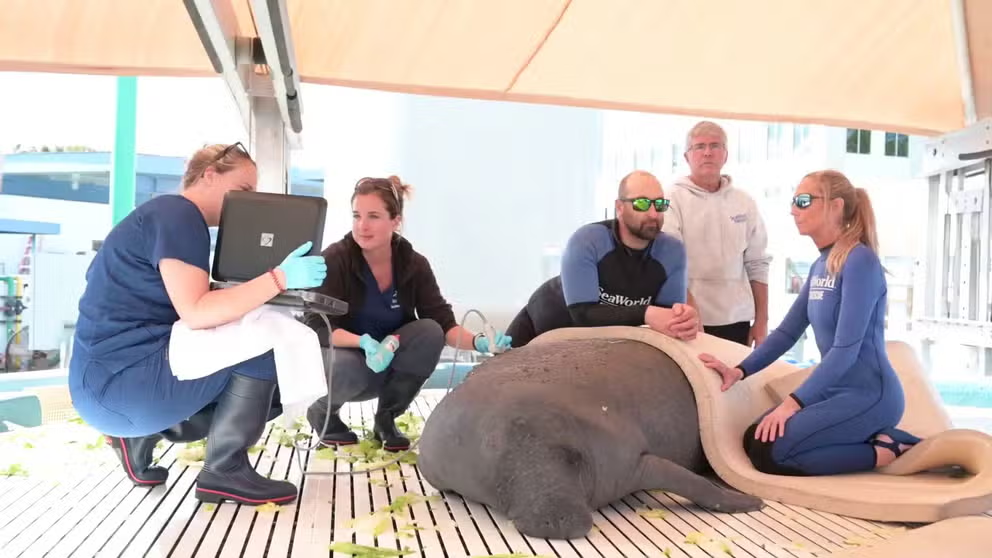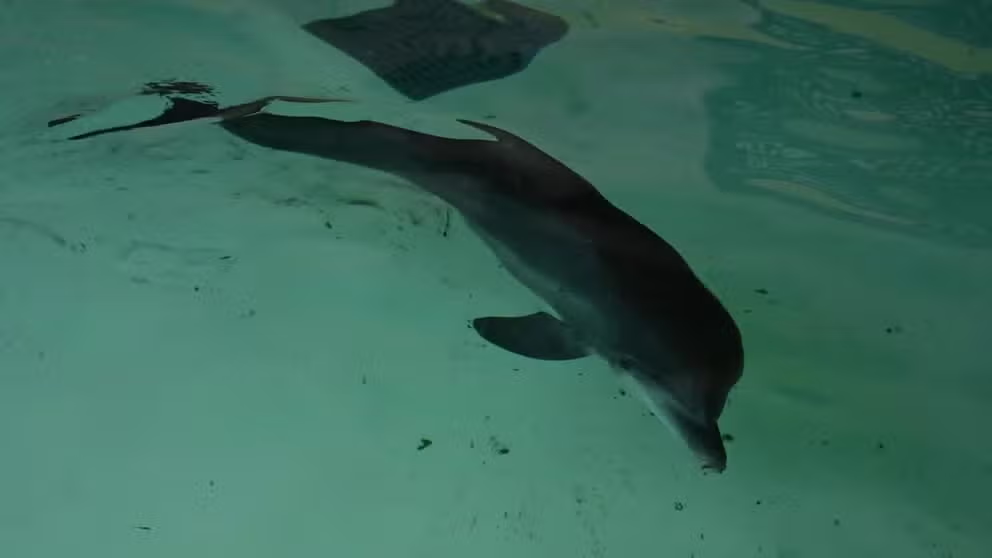SeaWorld vets saving marine species one animal at a time
Meet women making history and making sure future generations can enjoy threatened species.
Manatee rescue and rehabilitation
A team of SeaWorld Rescue specialists work with Manatees. They bottle-feed some, diagnose and hopefully release them back into the wild.
ORLANDO, Fla. – Veterinarians at SeaWorld not only preserve history but care for and rehabilitate animals to make sure that future generations can enjoy species like sea turtles, manatees, whales, and other threatened and endangered species. FOX Weather continues to celebrate Women's History Month by shining a spotlight on two unsung heroes.
CELEBRATE WOMEN'S HISTORY MONTH: FOX WEATHER'S WOMEN CONTINUE TO REWRITE HISTORY
"There are times when I take a step back and sort of realize the enormity of what might be happening," said Stacy DiRocco, SeaWorld veterinarian. "But we always have an obligation to our patients, so you can't get too caught up in it and then lose focus. So the only way to really successfully deal with it is one patient at a time."
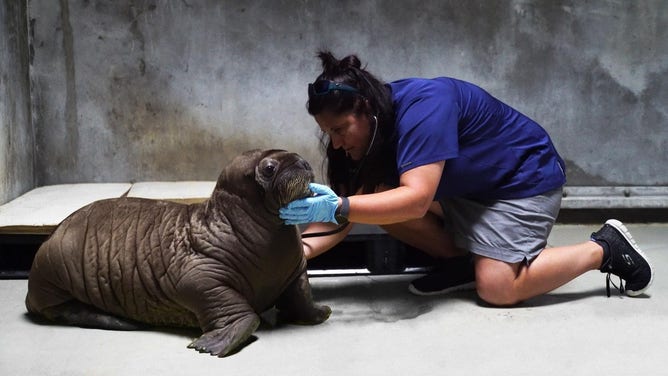
SeaWorld veterinarian Stacy DiRocco examines a walrus.
The senior veterinarians diagnose, treat and nurse animals back to heath. Each rescued patient that they release back into the wild could procreate to establish a new generation that is hopefully more stable than the last. But, DiRocco and her associate Lydia Staggs said that they rarely focus on that bigger picture.
DiRocco grew up in landlocked Ohio and was not exposed to a wide variety of aquatic life except for her occasional visits to SeaWorld Ohio before it closed. Seeing the animals up close was unbelievable but not her future she claimed.
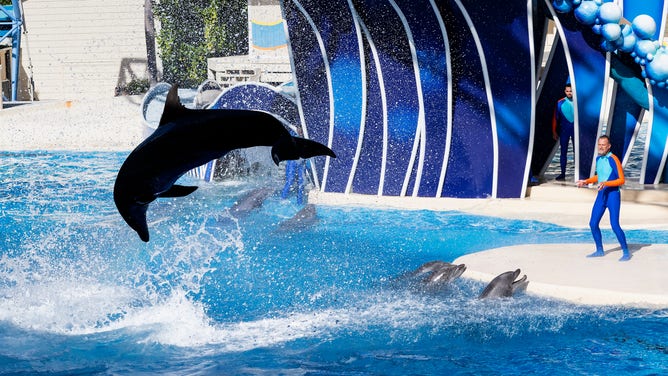
SeaWorld's dolphin show
(John Greim/LightRocket via Getty Images / Getty Images)
"I had no intention whatsoever of becoming a veterinarian. I actually wanted to be a lawyer when I was growing up," said DiRocco, who found biology and ecology classes more stimulating halfway through college. "I also started working at SeaWorld San Diego in my summers because I went to college in Southern California. It was a dream to be able to work there."
She stayed on as an animal keeper (zookeeper) after graduation.
"I think the thing that really motivated me the most was the rescue rehab program," DiRocco recalled. "I loved bringing in these animals, watching them turn around and helping them and then being able to send them back out."
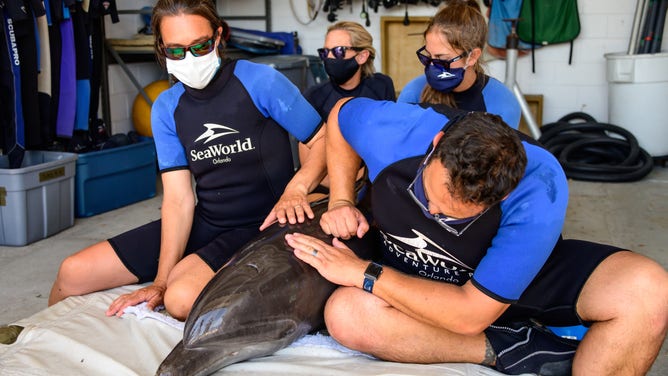
A team rescues a dolphin.
(SeaWorld)
The clincher was J.J. the whale. Rescuers moved a week-old, female California Gray Whale near death to SeaWorld for rehabilitation. DiRocco remembers making formula and bottle-feeding the baby every day. DiRocco's care enabled J.J. to gain almost 75 pounds a day and grow from a sick 1,300-pound whale to a 30-foot-long, 28,000-pound whale in 15 months.
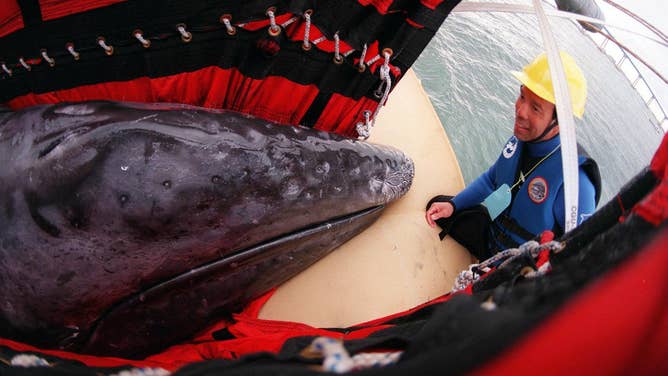
POINT LOMA, CA - J.J., the orphaned California gray whale, is ready to be lowered into the ocean 15 months after rescue.
(JOHN GIBBINS/AFP via Getty Images / Getty Images)
"That really inspired me because it wasn't just about what we did on a day-to-day basis, it took the entire park," said DiRocco of the larger-than-life experience. "It was such a community atmosphere and people were coming from all around to see this animal because it was such a rare event to see a California gray whale up close and watch this animal grow and progress. It was just an amazing and inspiring experience. That one's going to be hard to top."
Staggs' future was sealed at age 7 when she was picked out of the crowd to be part of the dolphin show at an aquarium. She also grew up in a landlocked state, Kentucky.
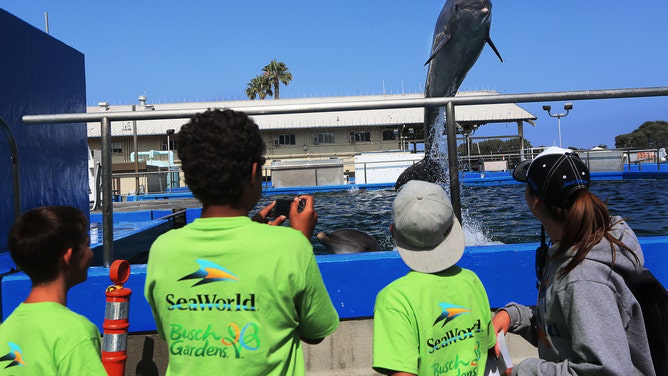
(Sandy Huffaker/Corbis via Getty Images / Getty Images)
"I told my parents, 'I'm going to do this. I am going to be a marine biologist someday,'" said Staggs. "And they're like, 'Yeah, yeah, that's great.' And I'm like, 'No, I'm going to do it.'"
As a community service requirement for her undergraduate graduation, she rescued and rehabilitated marine mammals with Mote Marine in Sarasota, Florida. She found her passion and then went to vet school.
Rescued dolphin gets a check-up
Lydia Staggs, SeaWorld veterinarian examines a rescued bottlenose dolphin calf.
Staggs recently had a celebrity patient which reminded her how famous and beloved her patients are and felt a little stress. A manatee with pneumonia came in with a freeze brand identifier from a previous rescue but no microchip.
After much research, she found this was Chessie, the Manatee from Chesapeake Bay rescued by SeaWorld 20 years ago.
"When we announced that we had Chessie in rehab, I'm thinking, 'Oh, that's pressure.'" Staggs said. "I could not let this animal die. I have to rehab this animal. I have to fix him."

The Florida Wildlife Commission notes Chessie's scar pattern for indentification.
But traditional antibiotics weren't working. Just like in the case of JJ, the community came together and brainstormed a solution.
"So we got really creative and we built a nebulizer. We converted an equine nebulizer, which has the silicone shape over it, and you can put it perfectly over their nostrils and the staff nebulized Chessie with antibiotics," said Staggs of the breathing device which dispenses medication made for a horse. "So then he got returned, and it was great and wonderful, but it was that was one of those [cases] with pressure."
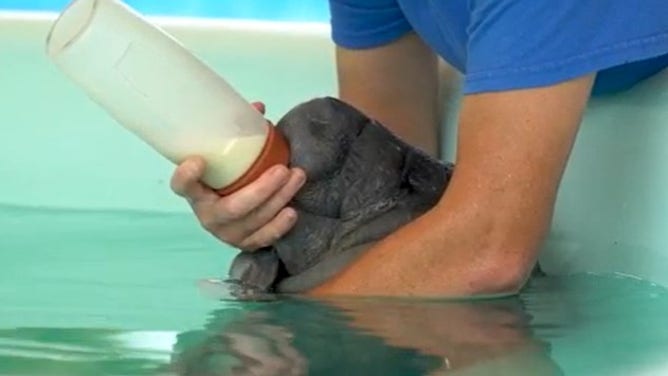
A member of SeaWorld's Manatee Rescue team bottle-feeds a calf.
(Sea World)
"When you sit at home at night and you kind of think about it, that's when you're like, 'Oh yeah, I am helping to save a species,'" said Staggs. "Every animal to me is precious, whether it be a non-endangered species or an endangered species… They get the same attention to detail, and it's just providing health and comfort to that individual and making sure you do the right thing for that animal at that time."

A manatee rehabilitating at SeaWorld.
DiRocco agreed that manatee rescues have been and will continue to be stressful.
"I worry sometimes about the biologists with manatees right now because they are out there on the front lines, doing the rescues, but also doing the necropsy. Just seeing the sheer numbers of animals that we're losing has got to be devastating for them," said DiRocco. "It is extraordinarily hard, and you have to learn from it… Cherish the moments when you have success."
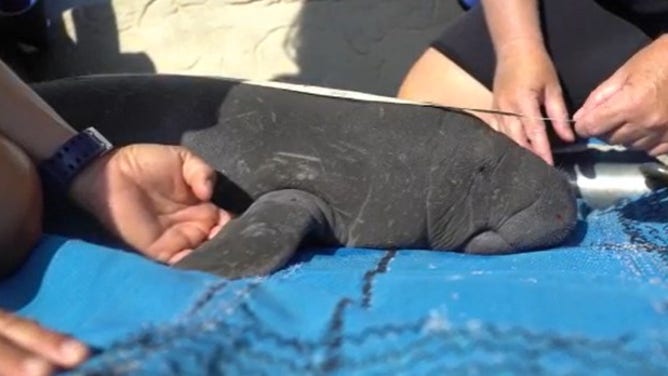
One of those successes is DiRocco's namesake, and still has a special relationship with her. While she was at San Diego's SeaWorld, a premature California sea lion pup came in.
The mother suffered seizures from neurological damage from an algal toxin and couldn't care for a pup. Many premature pups died but this one was healthy, boisterous and active. The sea lion was born on DiRocco's birthday, so her colleagues named the pup Rocco.
WOMEN'S HISTORY MONTH: PIONEERING THE WAY FOR WOMEN IN WEATHER
"We hand raised him. I have pictures of me bottle feeding this little California sea lion. And when he grew up, he did fantastically well," said DiRocco. "But because he had to be hand-raised, he couldn't be released. And he grew up in SeaWorld San Diego."
Rocco was transferred to SeaWorld Orlando as an adult and DiRocco joined him a few years later.
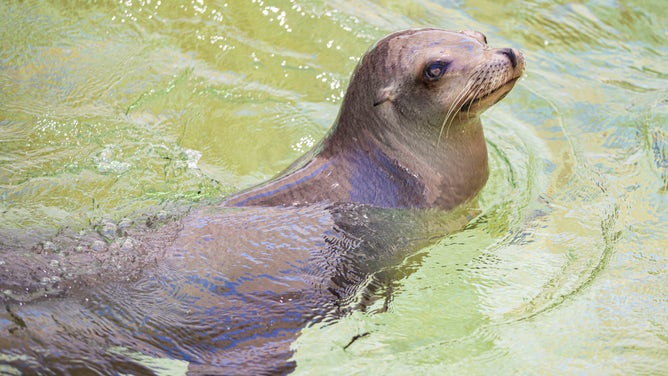
A California sea lion swimming in SeaWorld's sea lion habitat.
(Daniel Knighton/Getty Images / Getty Images)
"So when I came back to Florida in 2012, there's tiny Rocco, that was a baby when I knew him, is now about an 800 pound male California sea lion," marveled DiRocco. "I think for a lot of folks, because he can get up to eight, nine hundred pounds when he's in full breeding mode, are intimidated. So a lot of people kind of back off, and they're a little afraid, but I just let him come right up, and he knows that I'm not afraid of him, and he'll kind of snuggle in a little bit."
DiRocco is leaving Rocco for a month to study Alaskan ice seals with a NOAA research ship. She and biologists will study the health of populations of several seals amidst reducing sea ice concerns.
Staggs also works with NOAA. She surveys the health of marine animals and the environment in Barataria Bay, Louisiana which is still recovering from the Deep Water Horizon oil spill from 2010.
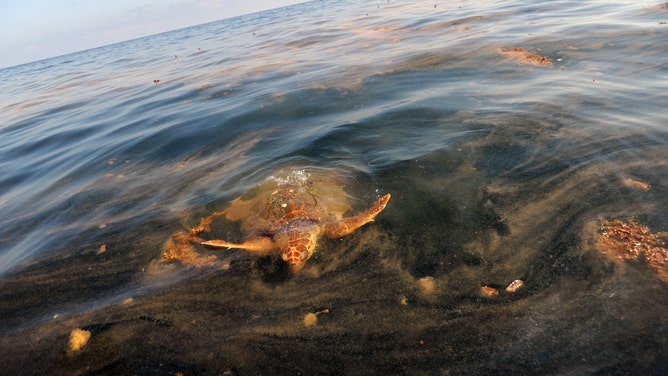
A sea turtle surfaces to feed on Portuguese Man-O-War contaminated with oil due to the spill from the Deepwater Horizon rig disaster in 2010.
( Carol Guzy/The Washington Post via Getty Images / Getty Images)
"This is my joy, this is my happiness," said Staggs. "The opportunities that I am allowed to do, that this girl from Kentucky, this landlocked state became a veterinarian at SeaWorld Orlando, which is one of the best zoological facilities to work out in the country… I want to inspire other children and other people to love the animals that I love, to do things to help the environment, to protect them and inspire future generations so that we have these amazing animals for our children and grandchildren."
